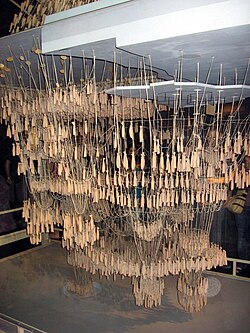Parametric design is a paradigm in design where the relationship between elements are used to manipulate and inform the design of complex geometries and structures.
The term 'Parametric' originates from from mathematics (Parametric equation) and refers to the use of certain parameters or variables that can be edited to manipulate or alter the end result of a equation or system. Parametric design is not a new concept and has always formed a part of architecture and design. The consideration of changing forces such as climate, setting, culture, and use has always formed part of the design process.[1]
Parametric modeling systems can be divided into two main types of systems:
- Propagation based systems where you compute from known to unknowns with a dataflow model.
- Constraint systems which solve sets of continuous and discrete constraints.[2]
Form-finding is one of the strategies implementing a propagation based system. The idea behind form-finding is to optimize certain design goals against a set of design constraints. [2]
History ( early examples)
Analogue parametric design

One of the earliest examples of parametric design was the upside down models of churches by Antonio Gaudi. In his design for the Church of Colònia Güell he created a model of strings weighted down with birdshot to create complex vaulted ceilings and arches. By adjusting the position of the weights or the length of the strings he could alter the shape of each arch and also see how this change influence the arches connected to it. After completing the model he would photograph it and invert it to see the model as it should look.
Properties of the method
This method has all the properties of a parametric model (input parameters, equation, output):
- The string length, birdshot weight and anchor point location all form independent input parameters
- The vertex locations of the points on the strings being the outcomes of the model
- The outcomes being derived by explicit functions, in this case gravity or Newtons law of motion.
By modifying individual parameters of these models Gaudi could generate different versions of his model while being certain the resulting structure would stand in pure compression. Instead of having to manually calculate the results of parametric equations he could automatically derive the shape of the catenary curves through the force of gravity acting on the strings.[3]
Sketchpad
Where Gaudi used physical laws to speed up his calculation of parametric equations, Ivan Sutherland looked to the processing power of digital computers.
Ivan Sutherland created an interactive computer-aided design program called Sketchpad. Using a light pen, users could draw lines and arcs that could be related to each other using constraints. These constraints contained all the essential properties of parametric equations. Users could experiment and explore different designs by altering the parameters of an entity and let Sketchpad do the calculations and redraw the geometry according to the constraints imposed upon it. [3]
Architecture
Nature has always served as inspiration for architects and designers. Computer technology have given designers and architects the tools to analyse and simulate the complexity observed in nature and apply it to structural building shapes and urban organizational patterns. In the 1980s architects and designers started using computers running software developed for the aerospace and moving picture industries to "animate form".[1]
One of the first architects and theorists that used computers to generate architecture was Greg Lynn. His blob and fold architecture is some of the early examples of computer generated architecture.
Urban design
Parametric urbanism is concerned with the study and prediction of settlement patterns. Architect Frei Otto distinguishes occupying and connecting as the two fundamental processes that are in involved with all urbanisation.[4] Studies look at producing solutions that reduce overall path length in systems while maintaining low average detour factor or facade differentiation.
Software
Catia
CATIA (Computer Aided three-dimensional Interactive Application) was used by architect Frank Gehry to design some of his award winning curvilinear buildings such as the Guggenheim Museum Bilbao. Gehry Technologies, the technology arm of his firm have since created Digital Project, their own parametric design software based on their experience with CATIA.
Grasshopper 3d

Grasshopper 3d ( originally Explicit History) is a plugin for Rhinoceros 3D that present the users with a visual programming language interface to create and edit geometry.
Components or nodes are dragged onto a canvas in order to build a grasshopper definition. Grasshopper is based on graphs ( see Graph (mathematics)) that map the flow of relations from parameters, through user-defined functions ( the nodes ), concluding in the generation of geometry. Changing parameters or geometry causes to changes to propagate through all functions and the geometry to be redrawn.[3]
Autodesk Revit
Autodesk Revit is BIM( Building information modeling) software used by architects and other building professionals. Revit was developed in response to the need for software that could create three-dimensional parametric models that include both geometry and non-geometric design and construction information. Every change made to an element en Revit is automatically propagated through the model to keep all components, views and annotations consistent. This eases collaboration between teams and ensures that all information such as floor areas and schedules etc. are updated dynamically when changes in the model are made.
See also
External Links
Grasshopper 3D
Designplaygrounds
References
<references>
- ^ a b c "Parametric Design: a Brief History". AIACC. Retrieved 5 April 2014.
- ^ a b c woodbury, Robert; Williamson, Shane; Beesley, Philip (2006). "Parametric Modeling as a Design Representation in Architecture: a process account". Cumulative Index of Computer Aided Architectural Design.
- ^ a b c d Davis, Daniel. "A History of Parametric". Retrieved 5 April 2014.
- ^ a b Schumacher, Patrik (2009). "Parametricism - A New Global Style for Architecture and Urban Design". AD Architectural Design. 79(4).
- ^ Woodbury, Robert (2010). Elements of Parametric Design. Routledge. ISBN 0415779871.
Category:Computer-aided design Category:Design Category:Architecture Category:Generative Design
((subst:submit))